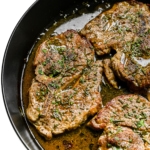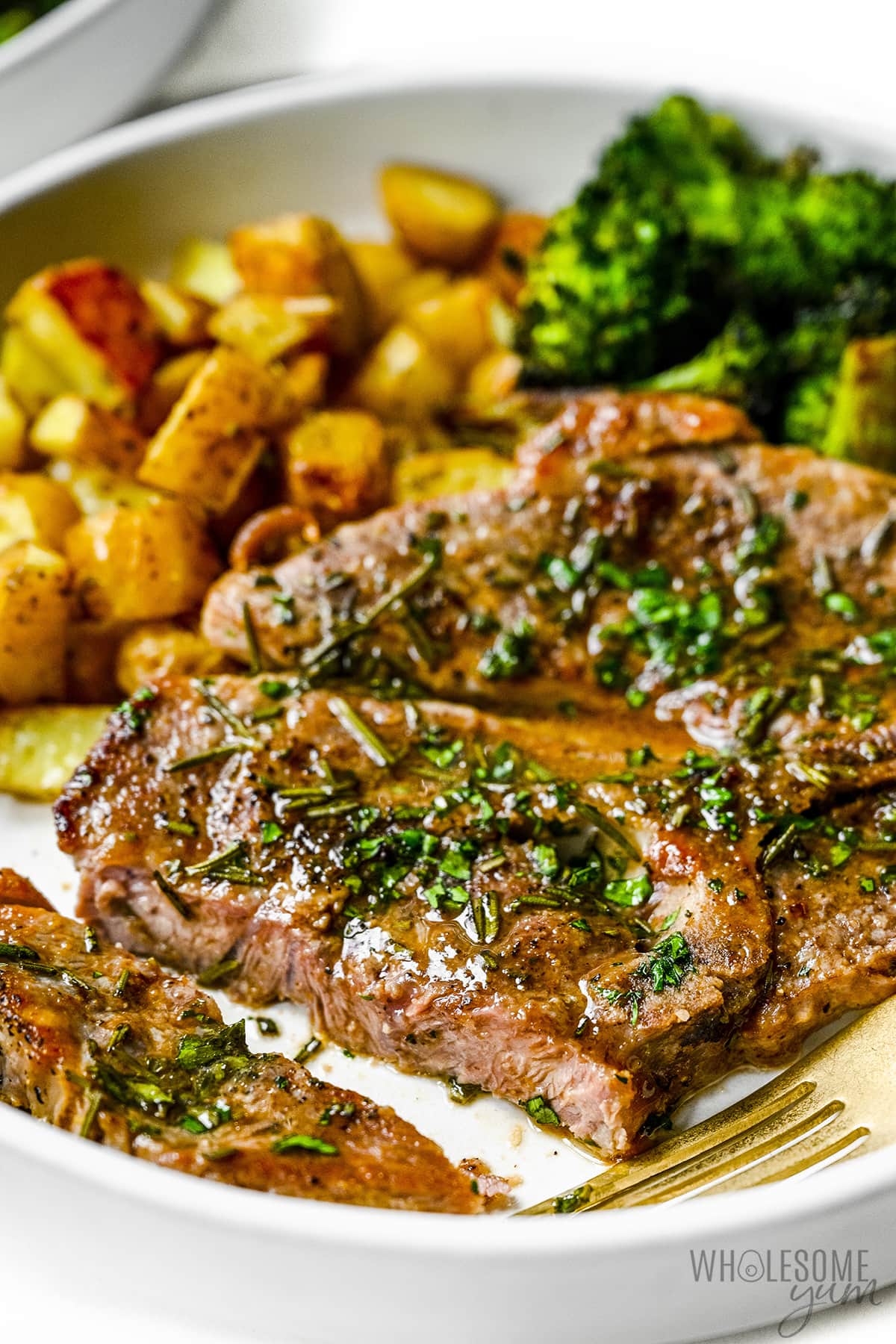Get rid of dry pork from your kitchen! My pork steak recipe will always be tender and juicy by baking it in the oven. This was my third try at cooking pork after my baked pork chops and air fryer pork chops showed me that I like it. And because I love my beef steak recipes, I had to try (a few times) pork shoulder steak. Delicious. The answer is delicious.
Pork is a versatile and affordable protein, but sometimes you just crave the hearty savory flavor of beef. With the right techniques, seasonings and cooking methods, you can transform mild pork into a satisfyingly beefy meal. This comprehensive guide reveals the secrets to making pork taste like the real deal.
Why Try to Make Pork Taste Like Beef?
There are a few reasons you may want that beefy flavor from your pork:
-
You love beef but want a less expensive alternative. Pork is typically cheaper per pound than beef.
-
You want to reduce red meat for health or environmental reasons Pork produces fewer greenhouse gases than beef
-
You need to avoid beef for dietary reasons but crave the flavor Pork can replicate the taste.
-
You want to use up ground pork but desire a different flavor profile. A few simple tricks can make that happen.
With the right preparation, pork can be magically transformed to hit that savory, beefy craving. Let’s explore some tips and tricks.
Seasoning is Key for a Beefy Pork Flavor
Seasoning is the easiest way to infuse pork with a deep, beefy flavor:
-
Worcestershire Sauce – A classic beef seasoning, it adds both sweet and savory flavors.
-
Soy Sauce – The umami-rich notes of soy mimic beef’s savoriness. Go for a dark soy for bolder flavor.
-
Liquid Smoke – Just a dash lends a smoky barbecue essence, similar to grilled beef.
-
Beef Broth – Substituting beef broth for cooking liquid is an easy flavor infusion.
-
Garlic and Onion Powder – These potent dried seasonings impart a quintessential beefy flavor.
-
Smoked Paprika – A touch of smoked paprika contributes subtle smokiness reminiscent of grilled beef.
Cooking Methods for Maximum Beefy Impact
How you cook the pork also affects how beefy it ultimately tastes:
-
Pan Sear – Get a nice sear on pork chops, browning the edges, for beef-like caramelized notes.
-
Slow Cook – Braising pork shoulder in beef broth coaxes out tender, fork-shreddable beefy flavor.
-
Grill – Charred, smoky grill marks on pork further the beef illusion through flavor and appearance.
-
Sous Vide – This gentle cooking method tenderizes pork for a supple, juicy texture just like beef.
Marinades and Rubs up the Beef Factor
For even more flavor impact, marinate or rub the pork before cooking:
-
Overnight Marinade – Soaking pork in a beefy marinade allows more flavor infusion. Try soy sauce, beef broth, liquid smoke, Worcestershire, etc.
-
Dry Spice Rub – Coat pork in a spice blend with garlic, onion, paprika, salt, and pepper before cooking.
-
Tenderizing Marinade – Use an acidic marinade with wine, vinegar, citrus, or yogurt to tenderize pork to a beef-like texture.
Pork Fat Content Affects Beefiness
The fat content of the pork also influences the end beefy flavor:
-
Ground Pork – Use a fat percentage closer to ground beef, like 80/20 or 85/15 for more authentic flavor.
-
Pork Shoulder – Well-marbled shoulder has a high fat content that mimics fatty beef cuts like chuck or brisket.
-
Bacon Drippings – Sautéing pork in rendered bacon fat adds a smoky, beefy note.
Putting it All Together for Maximum Beefy Impact
For the ultimate beefy pork, combine multiple techniques:
-
Marinate pork shoulder overnight in a soy sauce, beef broth, Worcestershire marinade.
-
Rub a spice blend on pork chops before grilling to get charred, caramelized flavor.
-
Pan fry ground pork coated in bacon drippings for an extra beefy taste.
-
Braise pork roast low and slow in beef broth until fall-apart tender.
With the right combination of preparation methods, even the most mild pork can reach the pinnacle of beefiness. Get creative with these tips for pork perfection with a beefy twist!
Troubleshooting for Best Beefy Results
Beefing up pork doesn’t always go smoothly. If your pork isn’t quite as beefy as desired, try these fixes:
-
Bland flavor → Add more spices, broth, Worcestershire, soy sauce, liquid smoke
-
Too firm texture → Braise or marinate longer to tenderize more
-
Too dry → Add extra broth or oil to cooking liquid to keep moist
-
Un-seared ground pork → Sauté over high heat to get browned crust
-
Not enough beef flavor → Mix in a bit of ground beef for more impact
With a few tweaks and technique adjustments, you’ll achieve the ultimate beef impersonation pork.
Satisfy Your Beefy Pork Cravings with These Recipes
Once you have the techniques down, it’s time to put them into delicious practice. Here are beefy recipe ideas to get you started:
-
Soy marinated pork tenderloin with charred onion relish
-
Slow cooked pork shoulder barbacoa tacos
-
Smoky pork meatloaf with bacon and charred tomato glaze
-
Crispy pork cutlets with garlic herb pan sauce
-
Pork larb lettuce wraps with spicy ginger dressing
-
Korean-style pork bulgogi stir fry with kimchi
The possibilities are endless for turning pork into a hearty, beefy meal. With the right balance of seasonings, cooking techniques, and recipes, you can fool your tastebuds and satisfy even the strongest beef craving. Just follow the tips in this guide for beefy pork perfection.
Frequently Asked Questions About Making Pork Taste Like Beef
Q: What cut of pork works best?
A: Shoulder and loin cuts have good marbling for most beef-like flavor and texture. Ground pork is also very adaptable.
Q: How long should I marinate the pork?
A: At least 2-3 hours, but overnight is ideal for maximizing the flavor impact.
Q: What liquid should I braise or simmer the pork in?
A: Beef broth, stock, or diluted bouillon are best to impart the most beefy flavor.
Q: Which spices boost the beefiness most?
A: Garlic, onion, paprika, salt, and black pepper are essential to amp up the beef flavor.
Q: Can I make a pork roast taste like beef?
A: Yes! Marinate in beefy liquids then braise low and slow until fall-apart tender, just like pot roast.
With the tips in this guide, you can unlock the secrets to transforming any pork into a hearty, crave-worthy beefy dish. Get cooking and satisfy your beef flavor cravings with humble pork. Your tastebuds will thank you!

More Easy Pork Recipes
Looking for more easy pork recipes? Try more of my readers’ favorites for easy dinners:
- Cast Iron Skillet—My cast iron can handle high temperatures, keeps heat in, and works great for my stovetop-to-oven method. This is the one I use for pork steaks because it’s big.
- Thermometer – Ensures that pork cooks to the correct temperature. I like to use a probe thermometer because I don’t have to touch the meat.
Recipe Card

How To Cook Pork Steak In The Oven
This section shows step-by-step photos together with the instructions, to help you visualize the recipe. For full instructions, including amounts and temperatures, see the recipe card below.
- Heat the oil. Place it in a big skillet that can go in the oven (cast iron is best) and set it over medium-high heat. Allow it to get very hot.
- Season the pork. Trim any excess fat off of each steak. Pat dry with paper towels. Season with salt, pepper, and garlic powder on both sides.
- Sear both sides. Place the steaks in a single layer in the hot pan. Sear until browned, then repeat on the other side.


- Add the sauce and herbs. Put some Worcestershire sauce on each steak, and then add some fresh herbs on top.
- Bake in the oven. When a meat thermometer reads 145 degrees F in the thickest part of the pork steak, they are done.
- Let them rest. Transfer the steaks to a plate or cutting board. Tent with aluminum foil to rest before serving.


![]()
- Bring the pork steak to room temperature if you have time. This is optional, but it helps with even cooking.
- Choose an extra large skillet, or use two. I used this 13-inch skillet to fit all 4 steaks. If they don’t fit, cook them one at a time or in two skillets.
- Use cast iron if you can. I think cast iron is the best way to cook any kind of steak, whether it’s my pork steak recipe or a beef steak like a top sirloin or ribeye. Cast iron pans get hot and stay hot longer than other types of pans. This helps steaks get a great sear and keeps the inside from cooking too much.
- Make your skillet sizzling hot before adding the pork. Otherwise, they won’t form that nice crust. The pan should heat up in two to three minutes. While you wait, season the pork. The oil should shimmer and slide around the pan easily.
- Check internal temperature with a meat thermometer. To make sure your pork steaks are cooked just right, but not too much, use a probe thermometer instead of an instant-read thermometer. For oven recipes like this, the probe thermometer beeps when it’s ready, so I don’t have to keep opening the oven door.
- Don’t forget to rest. A must for all of my meats! It keeps the meat from drying out and lets the juices settle inside.
- Store: For up to three to four days, put leftovers in the fridge in an airtight container. To keep them from drying out, I like to wrap them tightly in plastic wrap first.
- Reheat: To keep the meat’s moisture, I suggest putting pork steaks back in the oven at 350 degrees F with aluminum foil covering them. You can also heat it in the microwave, but it will bake more dry.
- Freeze: These are best when they’re fresh, but you can freeze them for up to three months after cooking them. Before you heat them up, let them thaw in a bag of cold water or in the fridge overnight.
![]()
Ideas for leftovers:
Cut the pork shoulder steak into small pieces to add to my hearty pork stew, or make thin slices to put on tacos or sandwiches. I change the chicken in my chicken Caesar salad or chicken lettuce wraps for beef in my steak salad every once in a while. Really though, it makes a great protein for any of my salad recipes.

This dish works well with a variety of sides. When I took these pictures, I served it with roasted potatoes and broccoli, but here are some other ideas:
